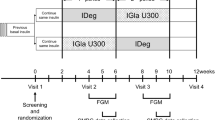Abstract
Aims
To evaluate diurnal patterns of plasma glucose in Japanese patients with type 2 diabetes receiving sulfonylurea and the effectiveness of daily premixed biphasic insulin analog (insulin lispro mix 50/50) injections plus sulfonylurea before breakfast (Mid mixture insulin analog-supported Oral Therapy, MOT).
Subjects and methods
Study 1: We evaluated 7-point plasma glucose profiles for 108 patients with type 2 diabetes stratified by their glycated hemoglobin A1c (HbA1c) levels into groups 1 (HbA1c < 7.4 %; n = 11), 2 (7.4 % ≤ HbA1c < 8.4 %; n = 33), 3 (8.4 % ≤ HbA1c < 9.4 %; n = 24), and 4 (9.4 % ≤ HbA1c; n = 40). Study 2: We initiated MOT in another 15 patients and evaluated its effectiveness for 24 weeks.
Results
We observed significant differences in mean plasma glucose levels between groups 1 and 2 after breakfast, groups 2 and 3 before dinner and at bedtime, and groups 3 and 4 during fasting and at bedtime. We observed significant postprandial changes in plasma glucose levels only before and after breakfast, and this was significantly higher in groups 3 and 4 than in group 1. A week after MOT initiation, the plasma glucose levels from the fasting period to before dinner decreased significantly, and HbA1c levels, which were 9.0 % at baseline, decreased significantly to 7.4 % at week 12 and 7.5 % at week 24.
Conclusions
We elucidated the association between plasma glucose levels after breakfast and HbA1c levels. From the results, MOT could be a promising strategy of early insulin initiation for patients with type 2 diabetes receiving sulfonylurea.



Similar content being viewed by others
References
Intensive blood-glucose control with sulphonylureas or insulin compared with conventional treatment and risk of complications in patients with type 2 diabetes (UKPDS 33). UK Prospective Diabetes Study (UKPDS) Group. Lancet 1998; 352:837–53.
Ohkubo Y, Kishikawa H, Araki E, et al. Intensive insulin therapy prevents the progression of diabetic microvascular complications in Japanese patients with non-insulin-dependent diabetes mellitus: a randomized prospective 6-year study. Diabetes Res Clin Pract. 1995;28:103–17.
Gaede P, Vedel P, Larsen N, et al. Multifactorial intervention and cardiovascular disease in patients with type 2 diabetes. N Engl J Med. 2003;348:383–93.
U.K. prospective diabetes study 16. Overview of 6 years’ therapy of type II diabetes: a progressive disease. U.K. Prospective Diabetes Study Group. Diabetes 1995; 44:1249–58.
Kobayashi M, Yamazaki K, Hirao K, et al. The status of diabetes control and antidiabetic drug therapy in Japan—a cross-sectional survey of 17,000 patients with diabetes mellitus (JDDM 1). Diabetes Res Clin Pract. 2006;73:198–204.
Masuda H, Sakamoto M, Irie J, et al. Comparison of twice-daily injections of biphasic insulin lispro and basal-bolus therapy: glycaemic control and quality-of-life of insulin-naive type 2 diabetic patients. Diabetes Obes Metab. 2008;10:1261–5.
Rosenstock J, Ahmann AJ, Colon G, et al. Advancing insulin therapy in type 2 diabetes previously treated with glargine plus oral agents: prandial premixed (insulin lispro protamine suspension/lispro) versus basal/bolus (glargine/lispro) therapy. Diabetes Care. 2008;31:20–5.
Japan Diabetes Society Guidelines for the Management of Diabetes based on Scientific Evidences. 2004.
The committee of Japan Diabetes Society on the diagnostic criteria of diabetes mellitus. J Diabetes Investig 2010; 1:17.
Monnier L, Lapinski H, Colette C. Contributions of fasting and postprandial plasma glucose increments to the overall diurnal hyperglycemia of type 2 diabetic patients: variations with increasing levels of HbA(1c). Diabetes Care. 2003;26:881–5.
Monnier L, Colette C, Dunseath GJ, Owens DR. The loss of postprandial glycemic control precedes stepwise deterioration of fasting with worsening diabetes. Diabetes Care. 2007;30:263–9.
Jovanovic A, Gerrard J, Taylor R. The second-meal phenomenon in type 2 diabetes. Diabetes Care. 2009;32:1199–201.
Roden M, Price TB, Perseghin G, et al. Mechanism of free fatty acid-induced insulin resistance in humans. J Clin Investig. 1996;97:2859–65.
Carey PE, Gerrard J, Cline GW, et al. Acute inhibition of lipolysis does not affect postprandial suppression of endogenous glucose production. Am J Physiol Endocrinol Metab. 2005;289:E941–7.
Ishii H. Quality of life in insulin-treated patients. J Jpn Diab Soc. 2008;51:8.
Acknowledgments
The study is not funded by a grant from any company. Drs. Tsuyoshi Mashitani and Yasuaki Hayashino are the guarantors of this work and, as such, had full access to all the data in the study and take responsibility for the integrity of the data and the accuracy of the data analysis. Tsuyoshi Mashitani searched the literature, conceived the study, analyzed the data, interpreted the results, and wrote the first draft of most sections of the report. Yasuaki Hayashino and Satoru Tsujii revised the report and participated in writing of the report. Naotaka Fujita, Satoshi Matsunaga, Rie Kurokawa, Hirohito Kuwata, and Hitoshi Ishii organised and supervised the study, interpreted the results, and revised the report.
Conflict of interest
The authors do not have any conflicts of interests.
Author information
Authors and Affiliations
Corresponding author
About this article
Cite this article
Mashitani, T., Tsujii, S., Hayashino, Y. et al. Diurnal patterns of plasma glucose in patients with type 2 diabetes receiving sulfonylurea and effectiveness of once daily lispro mix 50/50 injections. Diabetol Int 5, 30–35 (2014). https://doi.org/10.1007/s13340-013-0126-y
Received:
Accepted:
Published:
Issue Date:
DOI: https://doi.org/10.1007/s13340-013-0126-y




